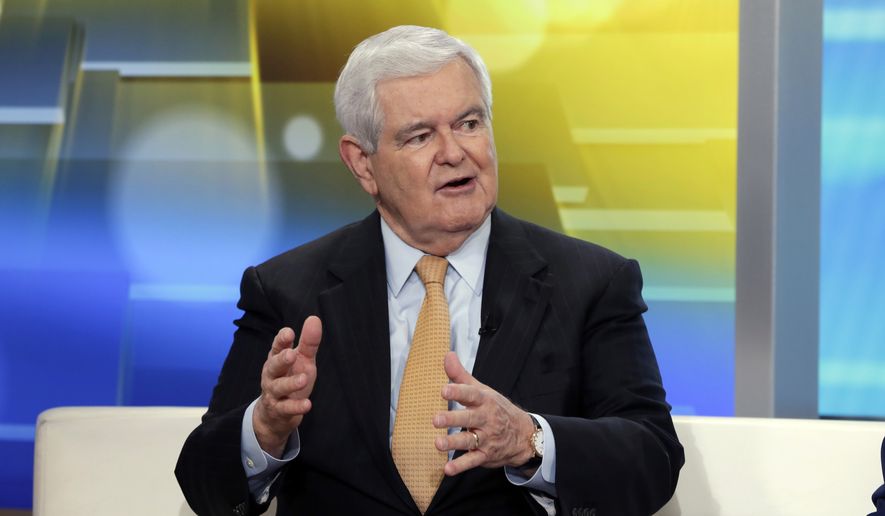Republicans have poll-tested a Contract with America-style agenda to carry into the fall elections as they ponder whether they need to give voters a bolder plan for what they will do if they keep control of Congress.
Former House Speaker Newt Gingrich, author of the 1994 contract that powered Republicans to their first House majority in decades, has been making the case for nationalizing the campaign.
John McLaughlin, a pollster, has tested one version of a national agenda that would involve Republicans backing term limits, paid parental leave and another round of tax cuts.
“I think there is a lot of interest in trying to figure out how we can focus our message and how we can maximize the impact of what we are accomplishing and draw a contrast with the left,” Mr. Gingrich told The Washington Times.
It’s not clear how widespread the appetite is for a contract-style message, though.
Top Republican aides said unity in messaging is important but they are more focused on touting their accomplishments over the past 20 months: tax cuts, a massive infusion of cash for the Pentagon and rolling back Obama-era policies.
It’s not clear what Republicans would write into a contract, should they go that route. Mr. Gingrich said it could take a few weeks for something to jell.
Mr. McLaughlin, in a poll last month, tested whether voters would respond to a Trump-backed plan for term limits on Congress, paid parental leave, making the 2017 tax cuts permanent, and “workfare,” or requiring able-bodied people receiving government benefits to prove they are attempting to find jobs rather than staying on the public dole for prolonged periods.
The platform tested surprisingly well, with 50 percent saying they would be more likely to back Republicans who embraced that plan. That included 45 percent of independents, compared with 31 percent who said they would be less likely to get behind a Republican promoting that agenda.
Matt Sparks, a spokesman for House Majority Leader Kevin McCarthy, California Republican, said party leaders have been talking about honing their brand, but that doesn’t necessarily mean agreeing on a specific platform.
What is clear, he said, is that President Trump’s to-do list has been — and will be — Congress’ agenda.
“We have started to fund the [border] wall, but we need to finish it. The administration has taken a tough approach on China, and Congress has too with new foreign investment requirements, but we need a more national strategy,” he said. “We passed spending cuts but need to cut much, much more.
“I think a big part of the message for why we deserve to retain control are the results of a stronger economy and communities and a stronger military,” he said. “The Democrats are quite simply against that. They want to pass single-payer health care, abolish [U.S. Immigration and Customs Enforcement] and impeach the president.”
Two months out from Election Day, political observers say Democrats are well-positioned to net the 23 seats they need to flip the House and are within striking distance of capturing the Senate.
Democratic leaders are promoting their own version of a contract, dubbed “A Better Deal.” But it doesn’t track with the bolder promises promoted by left-wing candidates for free college, government-sponsored health care and abolishing ICE.
Republicans have a long history with contracts, including the 1994 Gingrich plan that promised tax cuts and a balanced budget, along with major reforms to the way Congress operated.
In 2010, Republicans returned with their “Pledge to America,” a platform that harnessed the tea party’s anger at surging government spending and regulations under President Obama. They turned the pledge into an electoral weapon that helped them reclaim the House that year.
Mr. Gingrich, though, cautioned against drawing too many similarities between the Republicans’ task this year and what he accomplished in 1994. Instead, he said, the need for a national agenda this year is similar to the effort he helped organize as a backbencher in 1980, making sure congressional Republicans and President Reagan were on the same page with a five-point plan to cut taxes and strengthen the military.
“That year everyone was shocked,” he told The Washington Times. “We picked up 12 seats.”
In 1980, 1994 and 2010, Republicans didn’t control the White House or either of the legislative chambers, and were able to run as agents of change.
The roles are reversed this time, with Republicans holding the reins.
Mr. Gingrich said there is room for Republicans to ditch the district-by-district campaign approach and run a nationally branded campaign that makes clear that voters are choosing between “two competing alternative universes” in Democrats and Mr. Trump’s Republicans.
“We represent lower taxes, more jobs, rising take-home pay, the lowest black unemployment rate historically recorded, fewer people dependent on food stamps (because they are getting jobs), better trade agreements, less bureaucratic red tape and skyrocketing small business confidence,” Mr. Gingrich wrote in a recent political strategy paper. “The left represents higher taxes, more bureaucratic red tape, more people dependent on food stamps, and bankruptcy through a totally unaffordable government-run health care system. The opportunity for defining two alternative universes has seldom been better, nor the choice clearer.”
Mr. Trump has been stumping with candidates and delivering a message that Mr. Gingrich said is helping to highlight the contrasts.
“This election is a choice between Democrats who want to abolish ICE and Republicans who want to abolish MS-13. It’s very simple,” Mr. Trump said at a rally last week in Montana.
He has rejected talk of a Democratic wave in November and instead predicted that the country will be shocked by Republican victories.
Party strategists say the key to Republicans’ chances is to entice Mr. Trump’s most ardent supporters to the polls, and that means convincing them that voting for Republican congressional candidates means backing the president’s agenda.
“Republicans need to present a vision,” said Andy Surabian a former aide in the Trump White House. “They need to make clear that if you vote for Republicans in November we are going to fight to build the wall, we are going to fight to cut taxes more, we are going to fight to get rid of needless regulations, we are going to fight for national security, we are going to fight for the Trump agenda.
“People don’t typically vote on what has already been accomplished,” he said. “People vote on what they think you are going to do in the future.”
• Seth McLaughlin can be reached at smclaughlin@washingtontimes.com.




Please read our comment policy before commenting.